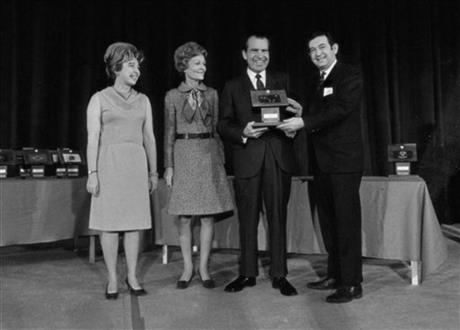Click here for iFriendly audio.
Steve Henrikson is the curator of collections at the Alaska State Historical Museum in Juneau. He’s encountered a lot of fascinating history in his job, but one of the most peculiar stories is the case of the missing moon rock.
“That’s one small step for man, one giant leap for mankind.”
The world watched and listened as Neil Armstrong became the first person to set foot on the surface of the moon on July 20th, 1969.
Museum curator Steve Henrikson remembers the moment well.
“My initial interest came when I was a little kid and I watched the Apollo missions on TV. And I remember at school when Apollo 11 actually landed on the moon, we had a big assembly. And they wheeled in the big, old, black and white TV—there was only one in the whole school at that time—on a big stand and the whole assembly watched the moon landing and I was just captivated,” said Henrikson.
Armstrong, along with fellow Apollo 11 crewmembers Buzz Aldrin and Michael Collins, carried many things back with them from that journey into space. They carried the pride of a nation, the amazement of the world, and 40 pounds of moon rocks.
That’s how two moon rocks ended up in the Alaska Transportation Museum in Anchorage, along with an Alaska state flag carried to the moon by NASA’s final moon mission, Apollo 17.
“We actually went to the Nixon Presidential Library and got photos of Richard M. Nixon handing the moon rock to our governor, Keith Miller, in 1969 and it was a gift to the people of Alaska,” said Henrikson.
One of the rocks was from Apollo 17. The other was from the Apollo 11 mission.
Fast forward to September 6, 1973. That day, an arsonist set fire to the museum. Henrikson says the rock survived the disaster. It was pulled out of the wreckage by the then curator’s 17-year-old stepson, named Coleman Anderson. He kept it and never told the museum where it was.
Henrikson began working at the museum two decades later, in the early 90s.
“And my first week of work, the former curator told me that we’d had another moon rock in the collection from Apollo 11, but that one had been stolen,” said Henrikson.
For nearly 40 years, the Apollo 17 rock and the flag sat on display alone, with only a blank space where the Apollo 11 rock should have been. The museum staff thought they would never see the purloined piece again.
“So, out of the blue, about two years ago, we were sued by the guy that had it. He was suing the state for ownership of the Apollo 11 moon rock that he admittedly took out of the museum. And I guess he felt that he had ownership of it somehow and he was challenging the state’s ownership of it,” said Henrikson.
A boy no longer, Anderson had grown up to become one of the most recognizable faces on American reality TV.
“He was one of the crab boat captains featured on the first season of ‘Deadliest Catch.’ So he was famous in his own right for that. But now he’s even more famous because he tried to get us to buy our moon rock back from him,” said Henrikson.
The state kept fighting—and won.
Meanwhile, the moon rock had been handed over to NASA for safekeeping. After the lengthy dispute, Henrikson said he was given the honor of bringing it home.
“I had the great pleasure of going down to the Johnson Space Center in Houston and going into the moon rock vault where the United States keeps most of its moon rock collection from all of the Apollo missions. And I retrieved Alaska’s moon rock and brought it back to Juneau and it’s been on display here ever since,” said Henrikson.
Late last year, the rock found its way to the State Museum.
And early this year, it found its way into the hands of one of the men who brought it to earth in the first place. Buzz Aldrin visited Alaska in early 2013. Henrikson had come to the same gathering to present on the case of the stolen moon rock.
He said it was an amazing moment when he got to personally tell Buzz Aldrin—his boyhood hero–how the museum had recovered its piece of space history.
“Buzz Aldrin himself says that it took the efforts of thousands of people to make that mission a success. And everybody had to work together—everybody from the astronauts themselves to the people that sewed up their spacesuits. And that’s one of the messages that the moon rock has to give to us today is that if we all work together, we can accomplish great things, things that you might think would be impossible. Sometimes the impossible can happen,” said Henrikson.
That’s why, Henrikson said, he takes Alaska’s moon rock to presentations around the state–to inspire the next generation of Alaskans to reach for the stars.
Henrikson is speaking about the case of the missing moon rock for the Chautauqua series at 7pm, Thursday, March 28, 2013 in the Nolan Center.












